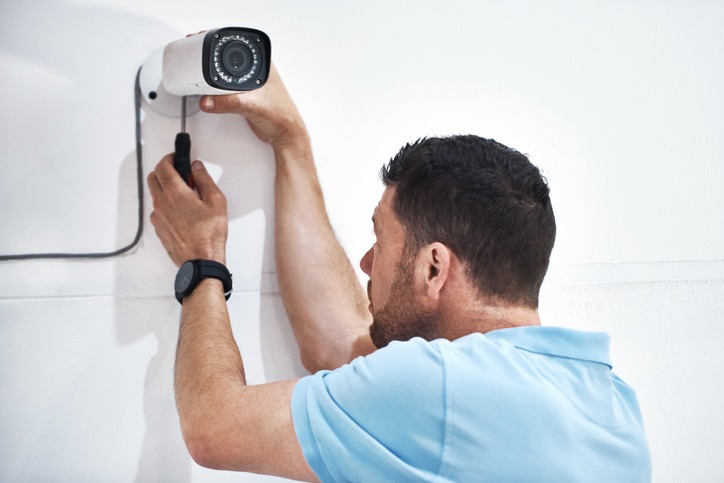We live in a world where security is of utmost importance. Your home is your castle, and it’s important to protect it from intruders and other hazards. One of the best ways to protect your home is to pursue security camera installation, whether it be with wired or wireless security cameras
Find out the differences between wired and wireless security cameras, as well as the benefits and drawbacks of each, so you can select the best camera for your property.
What are Wired and Wireless Security Cameras?
Wired security cameras are connected to a power source and your home’s internet network via a cable. They require a direct connection to a power source, such as an outlet or power adapter. The data transmission is usually done through a wired connection, such as a coaxial cable or Ethernet cable.
Wireless security cameras, on the other hand, are powered by batteries or a solar panel and use radio frequency or Wi-Fi to transmit data. They are generally easier to install than wired cameras and can be placed anywhere in your home.
Benefits of Wired and Wireless Security Cameras
The most obvious benefit of a security camera installation system is that it provides you with peace of mind. Whether it’s a burglary or a break-in, the cameras can help you identify the culprit and deter any potential intruders.
Another benefit of security cameras is that they can be used to monitor your home from anywhere. With a wired system, you can access the cameras from any device with an internet connection. With a wireless system, you can access the cameras from anywhere with a phone or tablet. Wired and wireless security cameras also offer a variety of other benefits, as they can be used to monitor suspicious activity, help with property management, and identify potential problems.
Types of Wired and Wireless Security Cameras
Wired security cameras come in many shapes, sizes, and styles. The most common types of wired cameras are dome cameras, bullet cameras, and hidden cameras that service your property in different ways. Dome cameras are typically installed on ceilings, while bullet cameras are usually mounted on walls, and hidden cameras are usually small and can be placed almost anywhere in your home.
Wireless security cameras come in many shapes and styles as well, including dome cameras, bullet cameras, and pan-tilt-zoom cameras. Wireless cameras are typically battery-powered and use radio frequency or Wi-Fi to transmit data and are generally easier to install than wired cameras and can be placed anywhere in your home.
How to Choose the Right Security Camera
When it comes to choosing the right security camera for your home, there are a few things to consider. First, think about what type of camera you need. Do you need a dome camera or a bullet camera? Do you need a hidden camera or a pan-tilt-zoom camera?
Once you’ve narrowed down your options, consider the features you want in a security camera that will ultimately add a layer of property protection. Do you want motion detection? Do you want night vision? Do you want two-way audio? Make sure the camera you choose has all the features you need. Finally, consider the cost of the camera. Wired cameras usually cost more than wireless cameras, but they may offer more features. Wireless cameras are typically more affordable, but they may not have as many features.
Pros and Cons
When it comes to wired vs wireless security cameras, each has its own set of pros and cons.
The biggest advantage of wired security cameras is that they are more reliable and secure than wireless cameras. Since they are connected directly to your home’s internet network, they are less susceptible to interference and hacking while also having a longer lifespan and requiring less maintenance than wireless
cameras. The biggest advantage of wireless security cameras is that they are easier to install than wired cameras. Since they don’t require a direct connection to a power source, they can be placed anywhere in your home and are more affordable than wired cameras and offer more flexibility in terms of placement.
The biggest disadvantage of wired security cameras is that they require a direct connection to a power source, which can be difficult to install. They are also less flexible in terms of placement and more susceptible to interference and hacking. The biggest disadvantage of wireless security cameras is that they require frequent battery changes. They are also more susceptible to interference and hacking and may not offer as many features as wired cameras.
Tips for Installing Wired and Wireless Security Cameras
When it comes to installing a security camera system, there are a few things to keep in mind. First, make sure the cameras are placed in areas that are out of reach. This will help deter any potential intruders and ensure that your cameras are not tampered with. Second, make sure the cameras are placed in areas with good lighting. This will help the cameras capture clear images of any potential intruders. Third, make sure the cameras are placed in areas with good Wi-Fi or radio frequency reception. This will ensure that your cameras are connected to the internet and can transmit data.
Finally, make sure the cameras are placed in areas that are not easily accessible. This will help ensure that your cameras are not tampered with or damaged.

